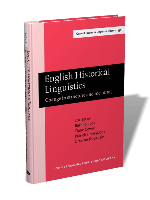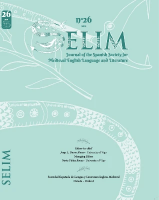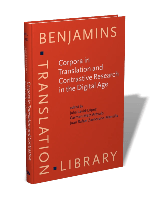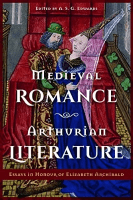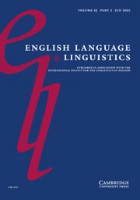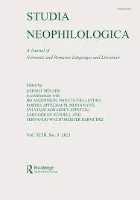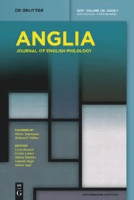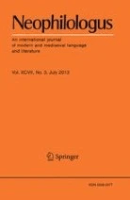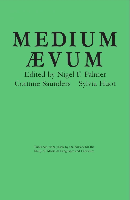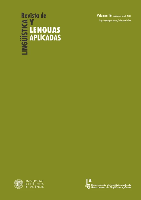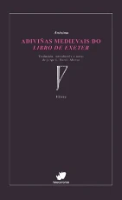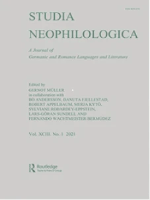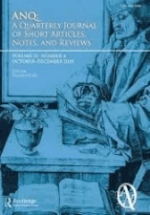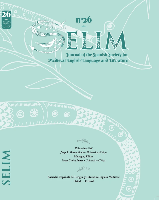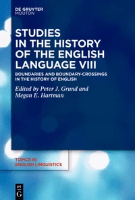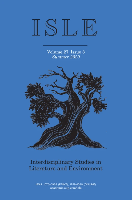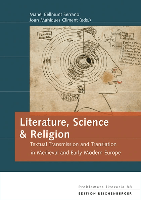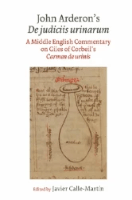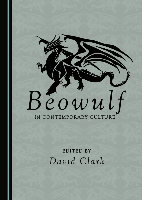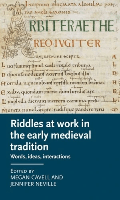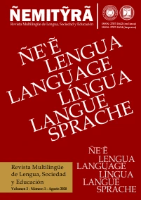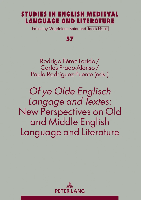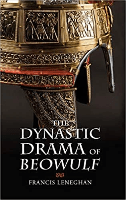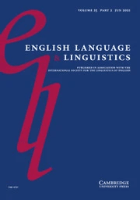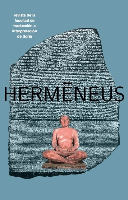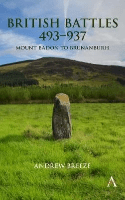


- Prizes & Awards
- …
- Prizes & Awards


- Prizes & Awards
- …
- Prizes & Awards

Our Members
SELIM is a small, but vibrant association of English philologists from various specialties. They are principally linguists and literary critics, textual scholars and historians. Although most Selimians are affiliated to Spanish universities, the international nature of our journal and conferences is encouraging the incorporation of a steadily growing number of scholars coming not only from the British Isles and the continent (the Netherlands, Italy, Germany, Austria, Hungary), but also from as far-off as the United States, Japan, and Paraguay. It is our pleasure to foster professional connections among them and publicise their activities to the wider audience through our media.
Their contribution to the field
Recent scholarship
'The role of (the avoidance of) centre embedding in the change from OV to VO in English'
Rodrigo Pérez Lorido
John Benjamins, 2022
Authors from Colman (1988) to Ogura (2001, 2004) have discussed the role of Relative Clause Extraposition as a means to avoid centre-embedded structures in OE, and its relevance as a factor in the change from OV to VO word order, but to date no study has addressed the full extent to which clausal embedding is allowed in OE. Based on an extensive corpus analysis, this paper provides evidence about the factors (both language internal and external) that interact in the generation of centre-embedded structures in OE while providing a reassessment of the role the avoidance of this kind of structures played in the change from OV to VO.
'Identifying the Old English exponent for the semantic prime LIVE'
Raquel Mateo Mendaza
SELIM, 2021
The aim of this article is to identify the OE exponent for the semantic prime LIVE following the principles of the Natural Semantic Metalanguage Theory. The methodology applied in the study is based on previous research in OE semantic primes. In these terms a search for those OE words conveying the meaning of the semantic prime LIVE is made. This search selects the verbs (ge)buan, drohtian, (ge)eardian, (ge)libban, and wunian as candidate words for a prime exponent. Then, these verbs are analyses in terms of morphological, textual, semantic, and syntactic criteria. The OE verb (ge)libban is selected as prime exponent.
'Word alignment in a parallel corpus of Old English prose'
Javier Martín Arista
John Benjamins, 2021
This chapter of Corpora in Translation and Contrastive Research in the Digital Age proposes a model of syntactic annotation for the Parallel Corpus of OE Prose, an aligned corpus of OE and Present Day English texts. The research focuses on areas of syntactic divergence between the aligned texts. Syntactic divergence is described in terms of four types of alignment asymmetry (markedness, constituency, order, and configuration) and is represented by means of two components: a structural description and a dependency tree. The main conclusion is that these two components constitute a historical micro-grammar that identifies stability and change with respect to specific categories and constructions.
'Noise, Sound and Silence in Sir Gawain and the Green Knight'
Jordi Sánchez-Martí
D S Brewer, 2021
This essay is part of Medieval Romance, Arthurian Literature, edited by A. S. G. Edwards in honour of the distinguished career of Professor Elizabeth Archibald. It concerns two areas that her scholarship has done so much to illuminate: medieval romance and Arthurian literature.
‘Cynthia L. Allen, Dative External Possessors in Early English'
Rodrigo Pérez Lorido, rev.
English Language and Linguistics 26.1, 2022
This monograph is the first large-scale corpus-based diachronic study of external possession (EP) constructions in the English language in which an NP in the dative case (dem Kind / them, possessor), which behaves as an external argument of the clause, establishes some semantic relationship of possession with another NP in that clause (die Haare / el dedo, the possesum). This structure was available in the Old and Middle English periods but preserved in Present-day English only in a few set phrases and expressions like look someone in the eye, having overall been replaced by internal possession (IP) structures...
'Old English verbs of depriving'
Miguel Lacalle Palacios
Studia Neophilologica, 2021
This article aims at providing an inventory of Old English verbs of depriving that is motivated not only by the shared meaning components but also by grammatical behaviour. The theoretical basis of this work combines the framework of verb classes and alternations and Role and Reference Grammar. The main conclusion is that the verbs āniman, bedǣlan, beniman, berēafian, berȳpan, bescierian and (ge)rēafian are the best candidates for class membership, considering the constructions and the morpho-syntactic alternations on which they are found.
‘Lability in Old english Verbs'
Luisa García
& Esaúl Narbona
Anglia 139/2, 2021
Present-Day English has an unusually high number of labile verbs, such as melt or burn, both cross-linguistically and with respect to genetically related languages. Comparison among early Germanic languages has allowed researchers to detect an incipient favouring of labile coding already in OE, where it is more frequent than in any other language of this group (Hermodsson 1952) and replaces causative coding in a considerable proportion of former causative verb pairs (van Gelderen 2011; García García 2020). This article attempts to map the chronological and textual distribution of labile verbs between the 7th and the 11th centuries CE in order to explore how lability develops throughout the OE period.
‘Beowulf 501b and the authority of OE poetical mss'
Rafael J. Pascual
Neophilologus 105, 2021
A. J. Bliss tacitly rejected Campbell’s theory of OE accentuation when he postulated the existence of metrical type 3B2. He based his analysis on the evidence afforded by four readings from Beowulf: ll. 501b, 932b, 949b, and 1830b. Non-metrical arguments in support of the emendation of 1830b had been advanced well before. This article offers new linguistic reasons for the emendation of l. 501b. It concludes that Bliss was unnecessarily cautious in his treatment of these verses and that, as Sisam memorably stated, conjectural emendation is a useful tool for the study of OE poetical manuscripts.
‘Hrothgar’s warhorse and the audience of Beowulf'
Rafael J. Pascual
Medium Aevum 90.1, 2021
Before his defeat at the hands of Beowulf, Grendel harassed the Danish court at Heorot, ceaselessly and with impunity, for a period of twelve long years. During that time, the Scyldings’ misfortune at the mercy of the monster became so notorious that it even made its way into song and story. It made sense then that the Scylding king repaid Beowulf's unexpected and much longed-for victory over Grendel with gifts of extraordinary generosity. Thus, Hrothgar does not content himself with bestowing on the hero four splendid pieces of battle-gear. He also provides Beowulf with a team of eight horses, among which is Hrothgar's own warhorse.
'Old English verbs of increasing'
Miguel Lacalle Palacios
Revista de Lingüística y Lenguas Aplicadas 16, 2021
This article aims at defining a class of Old English verbs of increasing based on both their common semantic components and grammatical behavior. On the theoretical side, the framework of verb classes and alternations is combined with Role and Reference Grammar. The data selected for this study have been extracted from both textual and lexicographical sources. After the analysis of the linking between syntax and semantics in this set of verbs, the conclusion is reached that āðindan, āweaxan, ēacan, (ge)ēacnian and (ge)weaxan are the best candidates for membership of the verbal class of increasing, considering the constructions and alternations that they present.
Adiviñas medievais do Libro de Exeter
Jorge Luis Bueno Alonso
Rinoceronte, 2021
The Exeter Riddles are short poems that invite us to identify an object, a natural phenomenon, an animal or a process described in a mysterious, enigmatic, and generally playful way, a challenge that leads us to a solution, several or none.
After Beowulf, this is the second book of Old English poetry that Jorge Luis Bueno Alonso has translated into Galician. 'Quen hai tan espelido, tan listo / que poia dicir quen me dirixe no camiño / cando, cheo de fereza, me con forza / berro con braveza e ás veces vou / por la terra toda traendo a ruina . . .'
‘A pandemonium of Borges: Introduction’
Miguel A. Gomes Gargamala
OEN 47/1, 2021
Atlas (1984) was one of Jorge Luis Borges' last projects, the result of the many journeys on which he embarked towards the end of his life in the company of his collaborator and later wife María Kodama. In the prologue Borges defines each entry in the volume as ‘a unit made of words and images.’ The short texts written by Borges alongside a selection of photographs taken by Kodama constitute neither an atlas nor a travel book, but a gateway to the geography and landscape of the Borgesian imagination. The reader is taken on a voyage around the globe, from ... Buenos Aires and Geneva to the Cretan labyrinth, from crepuscular Venice to the streets of Istanbul where once ‘Scandinavians served as the guard of the Byzantine emperor, who were joined by the Saxons who fled England after Hastings’ ...
‘Beowulf 1889b, Andreas 1221b and OE poetic style'
Rafael J. Pascual
Studia Neophilologica 93/1, 2021
In a short paragraph of his ‘Die Metrik des Beowulf’ (1885), Eduard Sievers proposed emendation of preterite plural bǣron to infinitival beran at l. 1889b. This emendation has much to commend it, but it has not been accepted by the majority of editors of the poem. This article adduces new palaeographical, metrical and stylistic evidence in support of Sievers’s proposal, and it also argues that the preterite plural forms bǣron and mǣton at Andreas 1221b and Beowulf 1633b should likewise be emended to infinitival beran and metan.
‘Sir Orfeo as the Source for the Topoi of Abduction and Otherworld inThe Hobbit'
Andoni Cossío
ANQ 2021
Among the medieval literature that Tolkien taught and studied, the pervasive prominence of ME works is steadily being recognized. Many literary pieces could fall under this category, but there is a clear example which remains understudied: Sir Orfeo (c. 1330). It underwent intensive scrutiny and appears to have left a deep imprint on Tolkien’s imagination which led to the inclusion of some reworked elements of this poem in The Hobbit.
'Old English verbs of learning'
Miguel Lacalle Palacios
SELIM 26, 2021
The aim of this article is to provide an inventory of Old English verbs belonging to the class of learning on the grounds of their common semantic components and shared grammatical behavior. The framework of verb classes and alternations and Role and Reference Grammar provide the theoretical basis for this study. Both textual and lexicographical sources have been used to select the data for the analysis of the linking between semantics and syntax with these verbs. The main conclusion of the article is that, considering the constructions and alternations in which they are found in Old English, the verbs (ge)frignan, (ge)leornian, ofācsian, and onfindan are the best candidates for membership of the class of verbs of learning.
‘Old English verbs of envy: Class membership and grammatical behaviour’
Raquel Vea Escarza
Studies in the History of the English Language VIII, 2021
This study addresses the grammatical behaviour and class membership of Old English verbs expressing 'envy', æfestian, andian, nīþan, and ofunnan, so as to determine the (in)consistency of their syntactic behaviour. It resorts to analytical criteria such as semantic and syntactic valence, morphological case of arguments, thematic relations, alternations, and nexus and juncture.
‘How Sir Gawain Shaped The Lord of the Rings’ Caras Galadhon'
Andoni Cossio
ISLE 27/4, 2020
Sir Gawain and the Green Knight is an anonymous 2,530-line poem with an approximate date of composition around the year 1400. The story begins in the court of King Arthur on New Year’s Day when Sir Gawain volunteers to take part in the mysterious Green Knight’s exchange-of-blows game. Despite being decapitated by Gawain, the Green Knight survives, and Gawain is forced to promise he will readily endure the Green Knight’s blow one year later at the Green Chapel...
‘Alan Lee’s illustrations of The Children of Húrin (2007) and The Fall of Gondolin (2018)'
Adriana Taboada González
Reichenberger, 2020
Two of the most recent editions of Tolkien's work, The Children of Húrin (2007) and The Fall of Gondolin (2018), include illustrations by Alan Lee. By providing a wider perspective of what the text is describing, Lee's art resembles the use of illuminations as visual translations of texts. This chapter analyses Tolkien's and Lee's work and the new readings afforded by their coalesence.
John Arderon's De judiciis urinarum
Javier Calle-Martín, ed.
U of Liverpool P, 2020
A synoptic edition of the English version of John Arderon’s De judiciis urinarum containing the commentary on Giles of Corbeil’s Carmen de urinis as preserved in Glasgow University Library, MS Hunter 328, from the early 15th century, and Manchester University Library, MS Rylands Eng. 1310, from the 16th century. A semi-diplomatic transcription, accompanied by a glossary, notes and introduction, the latter containing the textual transmission of the text, a codicological/palaeographic description together with the analysis of the scribal language.
‘Lofgeornost and the challenges of translating Beowulf'
Jorge Luis Bueno-Alonso
Cambridge Scholars Publishing, 2020
A re-evaluation of how the term lofgeornost has been dealt with in standard editions of the Old English text and translations of Beowulf into Spanish, Catalan and Galician, followed by a three-step proposal for the translating process of Old English poetry: editorial, translatorial, poetic. A significant contribution both to early medieval studies and to our understanding of Beowulf’s continuing cultural impact.
‘Grammaticalisation paths in the rise and development of aside'
Pérez Lorido, Rodrigo, with Pablo Ordóñez García
Research in Corpus Linguistics 8.2, 2020
An analysis of the grammaticalisation processes involved in the rise and development of the ‘a-adverbial’ aside: from coalescence-univerbation to development of abstract senses, extension of semantic range. Special attention is paid to the variation patterns of aside that existed in the Late ME period and their correlation with the geographic provenance of the texts.‘The nursemaid, the mother and the prostitute'
Mercedes Salvador-Bello
Manchester U P, 2020
It is firmly established that Anglo-Latin riddles were known on the Continent. The extent of their influence, however, remains unresearched. This chapter, 'The nursemaid, the mother, and the prostitute: Tracing an insular riddle topos on both sides of the English Channel', attends to the fruitful exchange of riddles on both sides of the English Channel and focuses on the metaphor of the nursemaid breastfeeding numerous children, a prostitute sharing her physical charms, as well as wine and food, with many men?
‘La visión de Tundal (Visio Tnugdalis)'
José Antonio Alonso Navarro
Revista Ñemityra 2/1, 2020
The Middle English Visio Tnugdalis, preserved in two copies of a 1483 London imprint, begins when Tundal is invited to dinner by a neighbour of his. Tundal suffers a seizure and apparently dies or temporarily looses consciousness. The soul leaves his body and travels to a bleak and dark place. ' Mientras el alma de Tundal se hallaba confusa, este vio aproximarse a un grupo de horribles demonios de aspecto aterrador que venían saltando y mostrando los dientes como lobos salvajes. . . .'
‘The deflexion and grammaticalization of the OE past participle with habban'
Javier Martín Arista
IJES 20/1, 2020
This article deals with the transitive construction involving habban and the past participle in OE, and focuses on the loss of the adjectival segment of the participial inflection. Inflectional morphology and constituent order, including the relative and the absolute position of the past participle, are considered. The data indicate that the reanalysis the habban+past participle construction is nearly over by the end of the period.
Of ye Olde Englisch Langage and Textes
Rodrigo Pérez Lorido et al.
Peter Lang, 2020
This edited collection tackles different aspects of Old and Middle English language and literature: English diachronic linguistics, OE metrics, corpus research with paleography in focus, the interplay language-register, and the periodology of Older Scots; literary and translatorial issues (the impact of Latin ‘quis’ on ME, translating Beowulf into Galician, a reinterpretation of Chaucer’s Knight’s Tale, and the structure of medieval miscellaneae) are addressed in the last part. Edited by Rodrigo Pérez Lorido, Carlos Prado Alonso and Paula Rodríguez-Puente.The Dynastic Drama of Beowulf
Francis Leneghan
D S Brewer, 2020
A strikingly original approach to Beowulf, linking its structure to the dynastic fortunes of the royal houses of the Scyldings, Scylfings and Hrethlings. It highlights the work's often-overlooked originality, by inserting the monster-slaying Beowulf into royal legend and providing explanations for features of the poem that have never been satisfactorily explained. It also brings into focus the poet's debt to biblical paradigms of kingship and considers how the Anglo-Saxons came to read Beowulf as their own Book of Kings.‘The basic valency orientation of OE and the causative ja-formation’
Luisa García García
English Language & Linguistics, 24/1, 2020
This paper takes a preliminary approach to the colonial element of Joseph Wright’s English Dialect Dictionary (1896-1905). Drawing on the electronic version of the dictionary that has recently been launched, it examines the entries which refer to the colonial usage of words documented in British dialects, considering the links that Wright made with Australia, Canada, Newfoundland, and New Zealand, as well as the isolated evidence recorded on items used in South Africa and the West Indies.
‘La dama priora (The Lady Prioress)'
José Antonio Alonso Navarro
Hermeneus 21, 2020
The Lady Prioress, an anonymous 15th-c poem preserved in London BL, MS Harley 78, fols. 74 r-77 v, tells the story of a beautiful prioress, who due to her great beuty, attracts the attention of three suitors: a young knight, a parish priest and a merchant. The three will insist the lady grants them her love and favours. She, a chaste and pure woman, will resort to her cunning and wit to defend her chastity at all costs. '¡Oh, Dios todopoderoso, que a nosotros todos gobernáis! Regocijaos con esta historia . . .'British Battles, 493-937
Andrew Breeze
Anthem, 2020
One of the most revolutionary books on war in Britain. It deals with 13 conflicts, either locating them correctly or explaining some of the aspects which have puzzled historians: Mount Badon (493) at Braydon, Wiltshire; battles of the legendary 'King Arthur' (536-7) in southern Scotland or the borders; 'Degsastan' (603) at Dawyck, on the River Tweed, Scotland; Maserfelth (642) at Forden, on the Welsh border; the Viking victory of 'Alluthèlia' (844) at Bishop Auckland, near Durham; and the English triumph of Brunanburh (937) at Lanchester, also near Durham.

'The Syntax and Semantics of the Old English Predicative Construction'
Javier Martín Arista
Brill, 2022

'The Semantic Map of Aktionsart and Lexical Entailment of Old English Strong Verbs'
Laura Fidalgo Allo
Journal of English Studies, 2022
Joining SELIM: https://www.selimsociety.com/the-society
